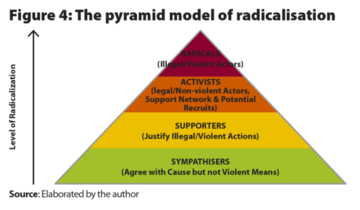The pyramid of radicalization is a theoretical model that helps us interpret and understand why people are radicalized, according to this theory, radicalization is the result of extremism of beliefs, feelings and behaviors in favor of conflict between groups and violence. ideologies, from religious beliefs to political beliefs.
According to the pyramid of radicalization, there are two forms of radicalization, one would be the radicalization of narrative or ideology, and the other, the radicalization of action; In addition, radicalization processes can occur at different levels: at the individual level, when a person radicalizes on his own; at the group level, when a group of people becomes radicalized; already mass level, when a larger group of people becomes radicalized.
- If the radicalization of actions is an individual or small group phenomenon.
- The radicalization of the narrative is a mass phenomenon.
- An entire country can come to radicalize its narrative and think that it is at war and must defeat an enemy.
- But those who fight will only constitute a small part of that population.
Pyramids used as a metaphor for explaining radicalization are like demographic pyramids, where most people are at the base of the pyramid; on the other hand, there are few people at the top in relation to the total population. , the pyramids have four levels.
In the case of the item pyramid, the first level is made up of the neutrals, this group would include people who do not follow a radical ideology and form the basis of the pyramid, if we level up we find sympathizers, who accept some radical ideas, such as the belief that there is a conflict against them.
Then there is the evidence, those who believe that the actions of radicals are usually justified and by their ideology; Finally, on the cusp of the pyramid are those who believe it is an individual duty to support and participate in radical actions, those who have a personal moral obligation. They believe that the threat under which they live justifies an individual obligation to act.
On the other hand, the pyramid of actions refers to the actions that people perform, their behavior, while the narrative pyramid refers only to the beliefs of people and the narrative they use, the pyramid of actions refers only to behaviors. The pyramid of radicalization of the action has four levels.
In the first level, which corresponds to the base, are the inert /inactive. Here, most people, those who do not act, do nothing in favor of a radical ideology. As we climb the pyramid, we find militants. Activists are those who take legal and non-violent actions, usually these actions are strikes and demonstrations that fall within the legality of each country and in which there are no violent acts.
At the next level of the pyramid are the radicals, they are those who carry out violent and therefore illegal actions, it is these people who destroy public property or even attack others. The last level, the top of the pyramid, is made up of terrorists, who are said to carry out illegal and violent actions, as well as radical ones, but joining an organization classified as a terrorist, whose target is civilians.
Climbing one pyramid does not automatically escalate another, one person can justify a conflict without acting. There are many examples in institutions that promote radio ideas but do not act, the opposite pole, that of people who become terrorists without having a radical ideology, is more complicated, but not impossible, taking radical measures and becoming a terrorist requires a justification that avoids cognitive dissonance.
However, it is common for both pyramids to scale at the same time. Let what anyone thinks go according to what they do. In addition, participating in a radical group allows you to learn the narrative and radical ideology, although there is no need to initiate radical action.
Finally, we find another peculiarity, that to climb the pyramid you can skip steps, it is possible that an inert person, who does not take any action to defend his group, begins to take radical measures, so it is necessary to take into account the dangers that a radicalization can pose so quickly.

